Benefits of L-Carnitine on Eye Health: Evidence, Uses, and Safety
Published: August 16, 2025
1. Introduction
L-carnitine is a naturally occurring compound that ferries fatty acids into the mitochondria—the cell’s powerhouses—to be converted into energy. Beyond its roles in metabolism and exercise recovery, emerging research suggests meaningful benefits of L-carnitine on eye health, including protection for retinal cells, support for tear film balance in dry eye, and potential help in age-related macular degeneration (AMD). This guide summarizes the most useful, parent- and patient-friendly insights.
2. What Is L-Carnitine (and ALC)?
L-carnitine is synthesized in the liver and kidneys and obtained from diet (meat, fish, dairy). Acetyl-L-carnitine (ALC) is a form that crosses cell membranes readily and is commonly used in supplements and research on brain and eye tissues.
3. Why the Eyes Might Benefit
- High energy demand: The retina is one of the body’s most energy-hungry tissues—healthy mitochondrial function matters.
- Oxidative stress: Light exposure and metabolism generate free radicals; antioxidant support may protect delicate structures.
- Tear film balance: Components in tears help protect the ocular surface; disturbances contribute to dry eye symptoms.
4. Evidence-Informed Benefits for Eye Health
4.1 Retinal Antioxidant & Mitochondrial Support
Laboratory and animal studies suggest L-carnitine helps limit oxidative damage and supports mitochondrial efficiency in retinal cells (photoreceptors and retinal pigment epithelium). Practically, this may help the retina cope with daily oxidative stress—from bright screens to sunlight—though human trials are still developing.
4.2 Dry Eye Relief & Tear Film Osmolarity
L-carnitine has been identified as a natural tear component, and lower levels have been reported in people with dry eye disease. Formulations that include L-carnitine (often in preservative-free lubricating drops) may help balance tear osmolarity, reduce surface stress, and improve comfort—especially in screen users or contact lens wearers.
4.3 Early-Stage AMD: Visual Function Support
Small clinical studies using acetyl-L-carnitine in combination with omega-3 fatty acids and Coenzyme Q10 have reported improvements in visual acuity, visual field sensitivity, and a reduction in drusen burden in early AMD. While larger trials are needed, this metabolic support approach is an intriguing adjunct for early disease management.
4.4 Neuroprotection in Optic Nerve Stress
Preclinical research indicates L-carnitine may reduce apoptosis (programmed cell death) in retinal ganglion cells, suggesting a potential neuroprotective role in conditions like glaucoma where oxidative and metabolic stress contribute to optic nerve damage.
4.5 Diabetic Eye Disease (Emerging)
Early findings link L-carnitine to improvements in oxidative balance and mitochondrial function in diabetic models. Clinical evidence is still limited, but this pathway is promising for future supportive care in diabetic retinopathy.
5. Practical Ways to Use L-Carnitine for Eye Wellness
5.1 Everyday Sources
- Diet: Beef, lamb, poultry, fish, and dairy provide L-carnitine naturally.
- Lifestyle: Sleep, UV protection, screen breaks, and balanced nutrition multiply the benefits of any supplement.
5.2 Supplements & Eye Drops
- Supplement forms: L-carnitine and acetyl-L-carnitine (ALC) are the most common. ALC is often used in research on neural/retinal tissues.
- Typical ranges used in studies: many human studies use hundreds to low thousands of mg/day (e.g., 500–2,000 mg of ALC), often split doses. Always personalize with your clinician.
- Artificial tears: Some preservative-free lubricating drops include L-carnitine to help comfort and tear balance in dry eye.
Important: Supplements are adjuncts—not replacements—for medical treatment. Ask your eye-care professional which form and dose fit your diagnosis and medications.
6. Who Might Consider It?
- Screen-intense users noticing end-of-day dryness or strain.
- Contact lens wearers seeking ocular surface comfort (with clinician guidance).
- Early AMD patients discussing metabolic support strategies with their retina specialist.
- Adults with metabolic risk (e.g., diabetes) under coordinated medical care.
7. Safety, Side Effects, and Interactions
- Common tolerance: Generally well tolerated; possible GI upset in some (nausea, cramps).
- Odor changes: Rarely, a “fishy” body odor (related to gut TMAO production); dietary tweaks or dose adjustments may help.
- Medical considerations: Consult your clinician if pregnant, breastfeeding, have kidney disease, seizure disorders, thyroid issues, or take medications (especially anticoagulants or thyroid/seizure medicines).
- Quality matters: Choose brands with third-party testing and use preservative-free eye drops when possible.
8. Bottom Line
Current evidence suggests meaningful benefits of L-carnitine on eye health: antioxidant and mitochondrial support for the retina, comfort gains in dry eye (tear osmolarity balance), potential neuroprotection for optic nerve stress, and early supportive data in AMD when paired with omega-3s and CoQ10. While larger clinical trials are needed, L-carnitine—via diet, targeted supplements, and select eye drops—can be a thoughtful addition to a comprehensive eye-care plan led by your eye doctor.


